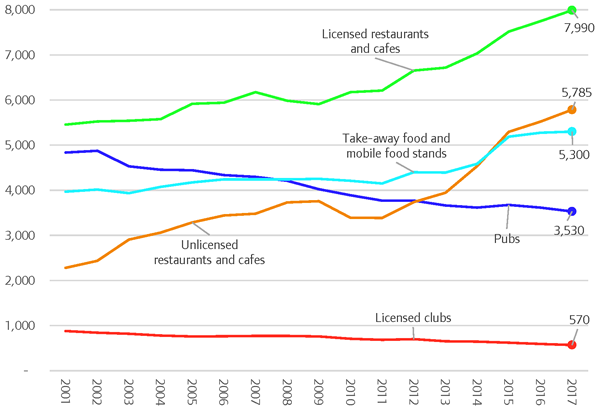London’s pubs audit 2018
In 2017 the GLA published a ‘pubs audit’, to look at what was happening to pubs in London. We recently updated this audit for 2018 – this blog outlines some of the findings.
The 2017 audit showed that the number of pubs had fallen by a quarter since 2001. In response, the GLA has moved to protect pubs through the planning system. For example, under the Draft New London Plan boroughs should refuse planning applications that involve the loss of valuable[1] pubs unless there is no prospect of the building being used as a pub in the ‘foreseeable future’. The 2018 update shows that this trend has continued, with a further 85 pubs lost between 2016 and 2017, a 2.4% fall. See Figure 1, below.
Figure 1: Number of pubs in London, 2001-17
Source: IDBR, ONS
The previous update highlighted the geographic unevenness of pub losses in London, and this is still the case. Some boroughs have seen significant pub losses (e.g. Barking and Dagenham, Newham, Waltham Forest, Croydon and Enfield lost about half their pubs between 2001 and 2017) whereas other boroughs have seen smaller losses or even increases (e.g. in Hackney there were 13% more pubs in 2017 than 2001).
One new element in the 2018 update is that we broke down the pubs trends by size, which was revealing. It turns out that whereas the number of small pubs (defined as having fewer than 10 staff) has fallen consistently since 2001, the number of large pubs (10 staff or more) has actually increased since 2011. As a result, there are now more large pubs than small pubs in London, with around 3,800 more people employed in London pubs in 2017 than 2001 (a 9% increase). This data may point towards changes in what pubs are offering in London, with more becoming ‘gastro’ pubs and becoming more food and family-oriented.
Figure 2: Trends in London pub numbers by size, 2001-17
Source: IDBR, ONS
Why are pub numbers in London falling, and should we be worried?
We have not yet looked into what is causing this decline in pubs. However, there are likely to be a number of causes. Changes in drinking habits are part of the story. People are drinking less, and beer is increasingly being bought ‘off trade’. Others have pointed to business rates and taxes on beer.
Fans of pubs will be concerned at this fall. However, should policy actively be intervening to reverse the trend? On the one hand, while there are fewer pubs, there are more restaurants and cafes. Figure 3 below shows the trends in the numbers of pubs, clubs, restaurants, cafes and take-aways since 2001[2]. While the number of pubs has fallen by 1,305 over this period, the number of restaurants and cafes has increased by over 6,000. So perhaps Londoners are simply changing how they spend their leisure time, switching evenings at the pub for meals and espressos.
Figure 3: Number of pubs and related business units in London, 2001 to 2017
Source: IDBR, ONS
However, there may be reasons to protect pubs. Pubs may have a unique value as a social amenity, offering a meeting place and bringing communities together in a way that cafes and restaurants don’t. Pubs may be more important as a social amenity in some places in London than others (perhaps where there are fewer other options for socialising), and more for some groups of Londoners than others (perhaps those with a stronger pub culture). This means that, on top of the geographic unevenness mentioned above (some places have seen more pub closures than others), there may be an unevenness in terms of social impact.
Another argument in favour of protecting pubs is for their intrinsic value as cultural and historic institutions. In London this may be less true of restaurants and cafes, although in other cities around the world, such as San Francisco and Buenos Aires, cafes and bars are protected for cultural and heritage reasons. Preserving these institutions may attract tourists, as well as being important for residents.
The protection of pubs in the Draft New London Plan draws on both the arguments above (pubs’ heritage / cultural value and their social value) and adds a third – their economic value.
What next?
GLA Economics will continue to update the pubs audit on an annual basis. Despite the Mayor’s planning intervention, the downward trend in pubs numbers seems likely to continue, given it is driven by changes in leisure and drinking habits. However, the Mayor has committed to undertaking research to explore the issue in greater depth, so we may know more next time. Meanwhile, GLA Economics will soon publish an evidence base on London’s night time economy, and the culture team will continue to develop policies to support London’s cultural infrastructure.
[1] Specifically, those that ‘have a heritage, economic, social or cultural value to local communities’.
[2] Data available on the datastore: https://data.london.gov.uk/dataset/pubs-clubs-restaurants-takeaways-borough




